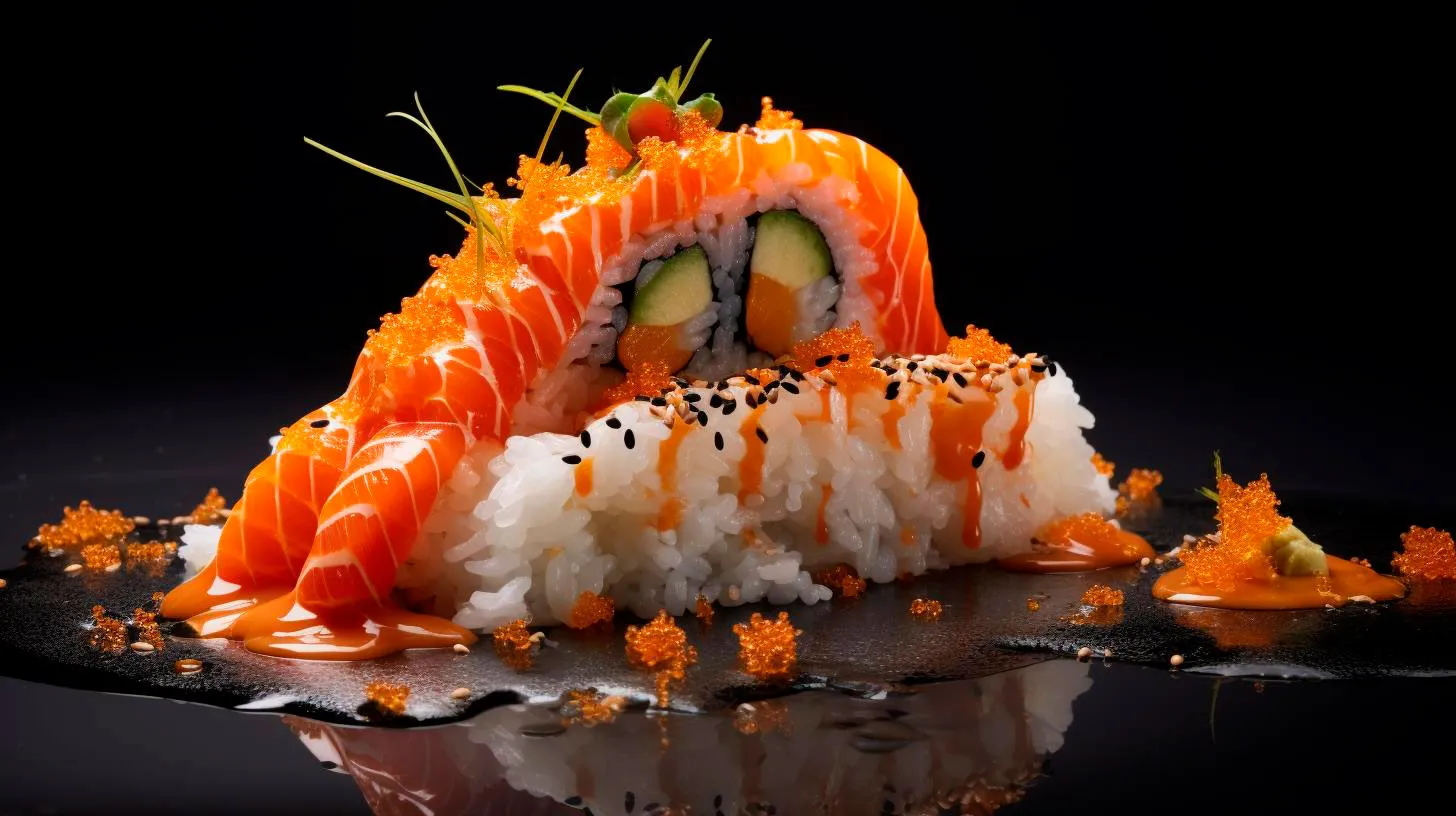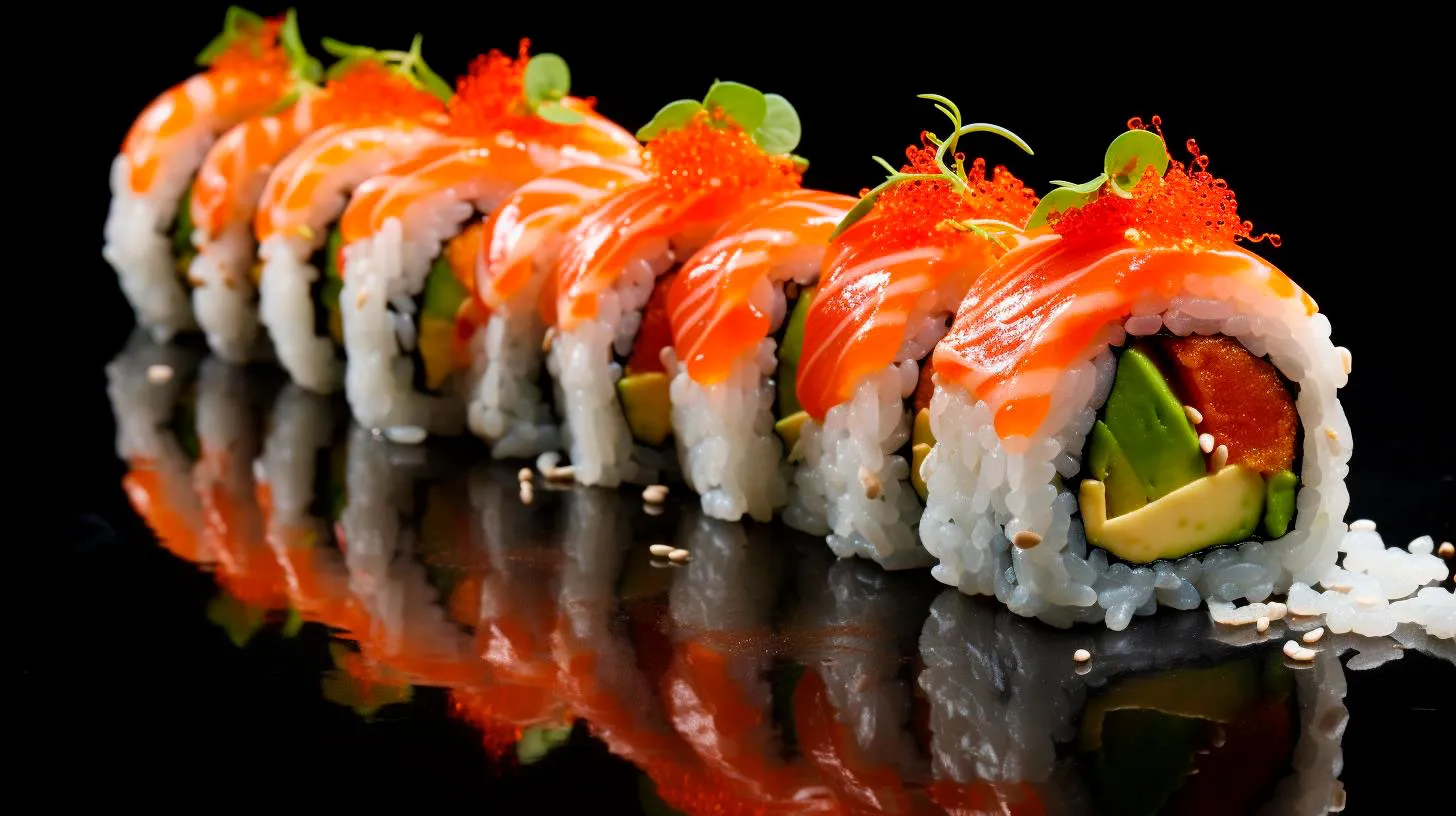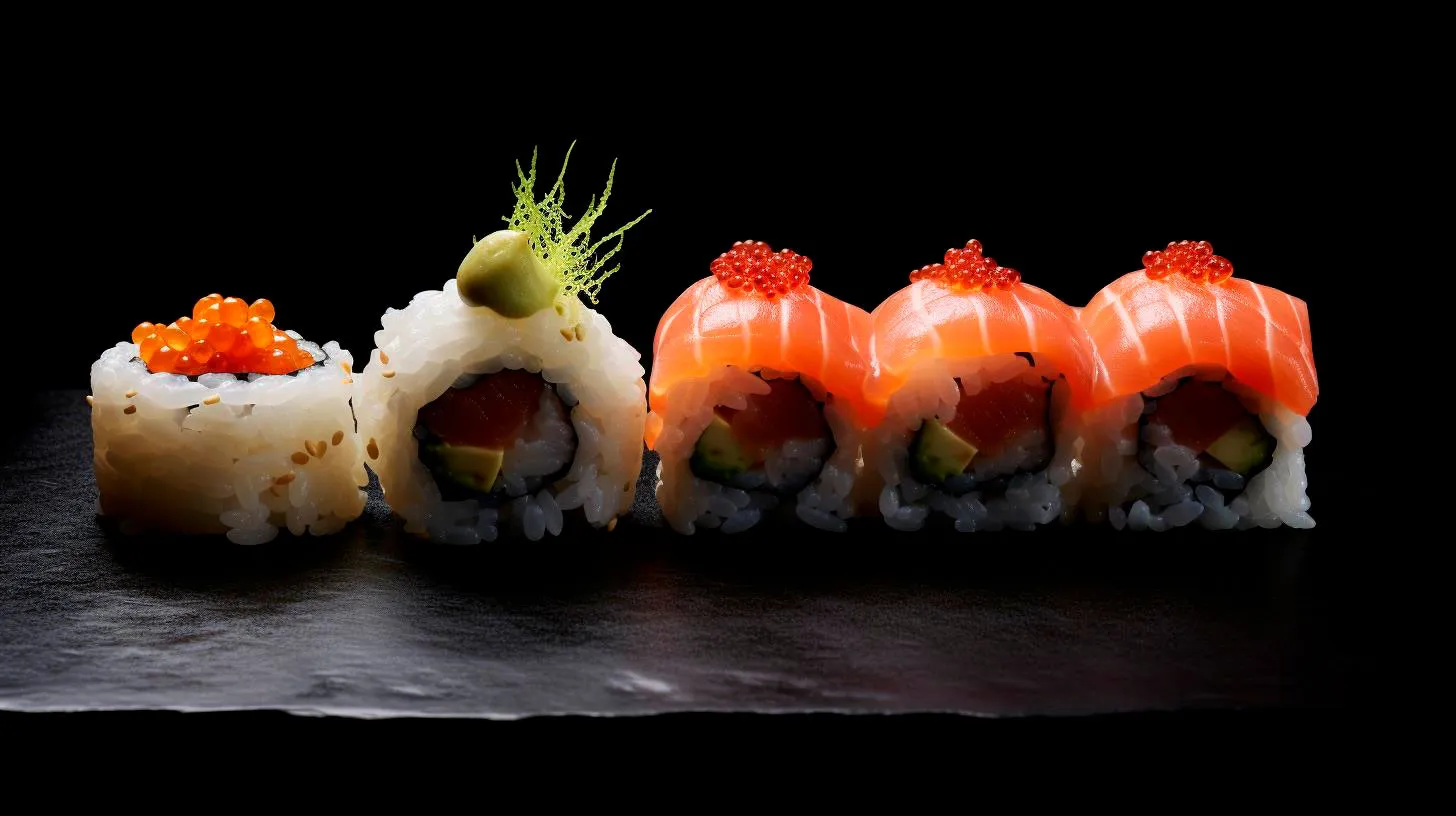A Chef Innovations in Sushi Pushing Boundaries and Redefining Tradition
In this article, we will explore some of the fascinating ways in which chefs are bringing innovation to sushi, taking the dining experience to unparalleled heights.
The Art of Fusion: Incorporating Global Flavors
Sushi is rooted in Japanese culture and tradition, but modern chefs are infusing it with flavors and ingredients from around the world. This fusion revolutionizes the sushi experience, offering exciting combinations that cater to a diverse range of taste preferences. Here are some remarkable innovations:
- Sushi Burritos: Blending the elements of traditional Japanese sushi with the convenience of a handheld burrito, these creations are a perfect fusion of East and West.
- Sushi Tacos: Adding a Mexican twist to sushi, these tacos provide a delightful combination of fresh seafood, vibrant vegetables, and zesty sauces.
- Sushi Pizza: By combining sushi ingredients like fish, rice, and seaweed on a crispy rice or nori crust, chefs have elevated sushi to an entirely new level.
These innovative creations cater to adventurous palates and attract a broader audience to the world of sushi.
From Sea to Beyond: Vegetarian and Vegan Sushi
Traditionally, sushi revolves around seafood. However, with growing dietary restrictions and environmental concerns, chefs are finding creative ways to cater to vegetarian and vegan diners. This culinary development, often called “veggie sushi,” has gained considerable popularity. Key innovations in vegetarian and vegan sushi include:
- Plant-based Substitutes: Utilizing ingredients like tofu, tempeh, and jackfruit to create sushi with flavors and textures similar to seafood.
- Vegetable Rolls: Showcasing an array of fresh and nutritious vegetables, these rolls offer a wholesome sushi experience without fish or other animal-based ingredients.
- Creative Fillings: Chefs experiment with unique fillings such as mushrooms, avocado, and seasoned rice to craft vegan sushi that bursts with flavor.
These developments not only cater to specific dietary preferences but also allow sushi enthusiasts to explore new taste dimensions, showcasing the versatility of this ancient delicacy.
Embracing Technology: Sushi Robotic Revolution
Technology continues to revolutionize various industries, and sushi is no exception. The rise of sushi robots in commercial kitchens has significantly impacted the sushi industry. Here are some ways in which technology is transforming sushi-making:
- Precision and Efficiency: Sushi robots automate the rice cooking and shaping process, ensuring consistent quality and speeding up production throughout restaurants.
- Creative Shapes: With the help of sushi robots, chefs can experiment with intricate sushi shapes, from delicate flowers to adorable animal designs, enhancing the visual appeal of the final dish.
- Hygiene and Food Safety: Sushi robots follow strict hygiene standards, minimizing the risk of contamination and ensuring a safe dining experience for customers.
The integration of technology in sushi-making not only streamlines operations but also frees up chefs to focus on creative aspects, resulting in a wider variety of visually stunning and delicious sushi creations.
Key Takeaways
As sushi continues to captivate the world, culinary innovators are constantly exploring new ways to redefine and enhance the dining experience. From fusion creations that blend global flavors, to vegetarian and vegan varieties, and the integration of technology in sushi-making, the possibilities seem endless. Key takeaways from this exploration of chef innovations in sushi include:
- Embracing fusion offers new and exciting combinations, appealing to a diverse range of taste preferences.
- Vegetarian and vegan sushi cater to dietary restrictions and provide a gateway for exploring sushi beyond seafood.
- Technology, such as sushi robots, brings precision, efficiency, and creative possibilities to sushi-making.
The sushi landscape is continually evolving, and these innovations certainly elevate the dining experience, inviting food lovers to explore the boundaries of tradition and indulge in extraordinary sushi creations.
The Evolution of Sushi From Traditional Delicacy to Global Sensation
A Brief History of Sushi
Sushi’s roots can be traced back to ancient Japan, where it originated as a preservation method for fish. In the seventh century, rice vinegar was introduced as a way to ferment the rice together with the fish, creating a new and unique flavor. Sushi quickly gained popularity and became a staple in Japanese cuisine.
- Sushi first emerged in Japan as a method of preserving fish.
- The addition of rice vinegar revolutionized the flavor of sushi.
- Over time, sushi became synonymous with Japanese culture and cuisine.
The Introduction of Sushi to the World
The globalization of sushi can be credited to the efforts of the Japanese diaspora and the growing popularity of Japanese cuisine worldwide. As people traveled and settled in different parts of the world, they brought along their culinary traditions, including sushi.
- The Japanese diaspora played a significant role in spreading sushi globally.
- Sushi chefs abroad adapted the traditional sushi recipes to suit local palates.
- The rising popularity of Japanese cuisine contributed to the global acceptance of sushi.
The Role of Technology in the Evolution of Sushi
Advancements in technology have also played a crucial role in the evolution of sushi. Traditional sushi-making required years of training and expertise, but with the advent of modern equipment and techniques, the process has become more accessible and efficient.
- Sushi conveyor belts revolutionized the dining experience, making sushi more convenient.
- Sushi-making machines have streamlined the preparation process.
- Online ordering and food delivery services have made sushi accessible to a wider audience.
The Health Benefits of Sushi
Aside from its delicious taste, sushi is also renowned for its health benefits. As a seafood-based dish, sushi is a great source of omega-3 fatty acids, which promote heart health and reduce the risk of chronic diseases. Additionally, the combination of rice, fish, and seaweed in sushi provides essential nutrients such as vitamins, minerals, and antioxidants.
- Sushi is a rich source of omega-3 fatty acids, essential for brain and heart health.
- The seaweed used in sushi is packed with minerals and antioxidants.
- The combination of ingredients in sushi provides a balanced and nutritious meal.
Sushi in Pop Culture
Over the years, sushi has made its way into pop culture, further solidifying its position as a global sensation. It has become a common sight in movies, TV shows, and even music videos, showcasing its widespread influence and appeal.
- Sushi has become a popular choice for on-screen dining scenes, adding a touch of sophistication.
- Celebrities and influencers have popularized sushi through their social media platforms.
- Sushi-themed merchandise, such as clothing and accessories, has gained popularity among enthusiasts.
Key Takeaways
Sushi has evolved from a traditional Japanese delicacy to a global sensation, captivating people’s taste buds all over the world. Its journey from a preservation method to a multi-billion-dollar industry showcases the power of cultural exchange and culinary innovation.
- The globalization of sushi can be attributed to the Japanese diaspora and the rising popularity of Japanese cuisine.
- Technological advancements have made sushi more accessible and efficient.
- Sushi offers numerous health benefits, thanks to its seafood-based ingredients.
- Pop culture has embraced sushi, showcasing its influence in various forms of media and merchandise.
Whether you enjoy traditional nigiri sushi or modern sushi rolls, there’s no denying the impact sushi has had on the culinary world. So the next time you indulge in this delectable dish, remember the rich history and global journey it took to reach your plate.
From Tokyo to the World: How Sushi Became a Global Culinary Phenomenon
In this article, we explore the incredible journey of sushi from the streets of Tokyo to its remarkable global success.
The Rise of Sushi
Sushi’s history can be traced back to ancient Japan, where it originated as a method of preserving fish in salted rice. However, it wasn’t until the early 19th century that sushi transitioned from being a street food to a carefully prepared culinary art.
The key turning point for sushi came with the introduction of vinegar-infused rice, which acted as a natural preservative. This innovation allowed sushi to be consumed fresh and contributed to its evolving flavors. By the mid-19th century, sushi stalls and small restaurants began to emerge, attracting locals and curious travelers alike.
International Expansion
The globalization of sushi can be credited to several factors. One significant catalyst was the increased accessibility of air travel, which allowed for the swift transport of fresh fish from Japan to other parts of the world. Additionally, the development of refrigeration and freezing techniques ensured that the quality and freshness of sushi ingredients were maintained during transit.
In the early 1960s, Tokyo hosted the Summer Olympics, providing an opportunity for the city to showcase its culinary prowess. Visitors from around the world had their first taste of authentic sushi, which left an indelible impression. As international travel grew, tourists returning home carried their newfound love for sushi, thereby fueling its demand beyond Japan’s borders.
The Sushi Revolution
By the 1970s, sushi had begun to make its mark in the United States and Europe. However, it wasn’t until the 1980s that sushi truly revolutionized the culinary scene, thanks to the introduction of the California roll. This Americanized version of sushi, which replaced raw fish with avocado, crab stick, and cucumber, eased the apprehensions of those unfamiliar with raw seafood.
The rise of health-conscious eating and the appreciation for freshness further contributed to sushi’s popularity. With its low-calorie content and high nutritional value, sushi was seen as a healthy alternative to fast food. This led to the rapid proliferation of sushi restaurants and the inclusion of sushi bars in mainstream supermarket chains.
The Key Takeaways
- Sushi’s journey from humble beginnings as a preserved fish dish to a global sensation is a testament to its timeless appeal and adaptability.
- The globalization of sushi can largely be attributed to the increased accessibility of air travel, advancements in refrigeration, and the influence of international events.
- The introduction of innovative sushi variations, such as the California roll, played a pivotal role in appealing to a broader audience and cementing sushi’s place in mainstream cuisine.
- Sushi’s reputation as a healthy and nutritious food option has fueled its popularity, leading to a proliferation of sushi restaurants and supermarket options worldwide.
In conclusion,
Sushi’s journey from Tokyo to the world is an extraordinary tale of culinary evolution. From its humble beginnings as a preservation technique to its current global popularity, sushi has fascinated people with its delicate flavors and artful presentation. This Japanese delicacy has not only conquered international palates but also served as a bridge for cultural exchange. As sushi continues to captivate food enthusiasts worldwide, it remains a shining example of how a traditional dish can transcend borders and become a true global culinary phenomenon.
The Rich Traditions Behind Sushi: An Ancient Craft Enduring Legacy
Join us as we dive into the fascinating world of sushi, exploring its ancient craft and enduring legacy.
Ancient Origins: The Birth of Sushi
Sushi’s roots can be traced back to 8th century Japan. Originally, sushi was a means to preserve fish by fermenting it with rice. This fermenting process allowed both the fish and rice to be consumed together. Over time, sushi evolved into a dish where the fish was served fresh with vinegared rice. In the Edo period, from the 17th to 19th century, sushi began to evolve into the form we are familiar with today.
Key Takeaways:
- Sushi originated in Japan as a way to preserve fish through fermentation.
- Over time, sushi transformed into a dish featuring fresh fish and vinegared rice.
- The Edo period marked a significant development in sushi, shaping it into its present-day form.
The Craft of Sushi-Making
Sushi-making is an intricate craft that requires years of training to master. Skilled sushi chefs, known as itamae, pay meticulous attention to every detail, from selecting the freshest ingredients to crafting visually stunning presentations. The precision and elegance associated with sushi-making have elevated it to an art form.
Key Takeaways:
- Sushi-making is a highly skilled craft that demands years of training.
- Attention to detail is crucial, from ingredient selection to presentation.
- Sushi-making is often regarded as an art form due to its precision and elegance.
The Health Benefits of Sushi
Aside from its exquisite taste and presentation, sushi also offers numerous health benefits. The primary ingredient in most sushi, fish, is a rich source of omega-3 fatty acids, which are essential for heart health and brain function. Additionally, sushi often incorporates nutrient-packed vegetables, such as seaweed, providing a range of vitamins and minerals.
Key Takeaways:
- Sushi is a nutritious dish packed with omega-3 fatty acids.
- Vegetables commonly used in sushi, like seaweed, offer additional health benefits.
- Consuming sushi can contribute to improved heart health and brain function.
Sushi Around the World
The popularity of sushi has transcended borders and cultures, with sushi restaurants now found in almost every corner of the globe. The artful combination of flavors and textures, along with the emphasis on freshness, has made sushi an international favorite. Today, you can find a variety of sushi styles, such as nigiri, maki, and sashimi, tailored to suit different tastes and preferences.
Key Takeaways:
- Sushi has become a global phenomenon, enjoyed by people from diverse backgrounds.
- Various sushi styles, including nigiri, maki, and sashimi, cater to different culinary preferences.
- The emphasis on freshness and flavors has contributed to sushi’s worldwide appeal.
Sushi: A Culinary Journey
Sushi stands as a testament to the rich history and evolving culinary traditions of Japan. From its humble beginnings to its global popularity, sushi has withstood the test of time. Whether you indulge in a classic nigiri platter or venture into more experimental sushi creations, each bite is a reflection of centuries-old traditions and the skill of the sushi chef.
So, the next time you savor a piece of sushi, remember the ancient craft and enduring legacy that has brought this exquisite dish to your plate. Join us in celebrating the traditions and innovation that continue to make sushi a beloved culinary experience worldwide.



